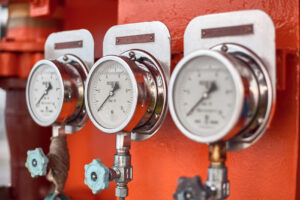
A pressure gauge refers to an instrument that uses elastic components as sensitive components to measure and indicate pressure higher than the ambient pressure. The application of pressure gauges is extremely common, and it covers almost all industrial processes and scientific research fields. It can be seen everywhere in the fields of heating pipe network, oil and gas transmission, water and gas supply system, vehicle repair and maintenance factories and stores. Especially in the process of industrial process control and technical measurement, because the elastic sensitive element of the mechanical pressure gauge has the characteristics of high mechanical strength and convenient production, the mechanical pressure gauge is more and more widely used. Then there will be pressure gauge product failures in practical applications.
Below we will briefly describe 7 common pressure gauge failures and their causes and solutions:
1. After the pressure is removed, the pointer cannot return to zero
If the pointer is bent or loose, it can be corrected with tweezers and tapped tightly after verification.
If the balance spring torque is insufficient, the meshing of the center gear and the sector gear can be disengaged, and the center gear shaft can be rotated counterclockwise to increase the balance spring reaction torque.
2. The pointer of the pressure gauge is beating or sluggish and does not rotate
There is friction between the pointer and the transmission gear. Adjust the meshing gap of the transmission gear.
The surface glass or the dial will rub against each other. The pointer can be corrected by thickening the washer under the glass or making the pointer shaft hole larger.
The central gear shaft is bent, the shaft diameter is not concentric, and does not match, you can remove the gear and use a wooden hammer to straighten it or straighten it with flat-nose pliers;
If there is dirt at the meshing part of the two gears, the two gears can be removed for cleaning.
If the movable screw between the connecting rod and the sector gear is inactive or the movable screw is loose, the thickness of the connecting rod can be thinned with a file.
3. Only a certain verification point is out of tolerance
On which scale is found to be out of tolerance, stop on which scale. Check the fit of the parts on the scale point, whether the drive shaft hole is blocked; whether the connecting rod is flexible; whether the tooth meshing point is damaged, foreign matter, etc., to be eliminated.
When a positive error occurs at a certain point, it is often due to dirt and burrs at the tooth meshing point; when a negative error occurs, it is mostly due to tooth shape damage or tooth damage. If the teeth are severely damaged, new ones should be replaced. When there is no new part to replace, the center wheel has broken teeth and the meshing position can be changed, so that the broken teeth can avoid transmission. If the sector wheels have broken teeth, they cannot be adjusted and must be replaced with new ones.
4. In use, the indicating value cannot be stable, and the pressure drops significantly
At this time, first, check whether the connection between the pressure gauge and the pressure gauge calibrator is leaking. If there is no oil leakage and the calibrator is intact, it indicates that the spring tube is leaking. The scale plate should be removed for further inspection.
The base itself has blisters, which gradually leak after long-term use. The base of the same specification needs to be replaced, and the low-pressure measurement can be repaired.
Long-term under the action of pulse pressure, the spring tube is fatigued or there is leakage at the sealing parts at both ends. The two sealed parts can be repaired or re-tightened. If it breaks, the spring tube will be scrapped.
The long-term corrosive action of the measured medium, the spring tube causes leakage. It is necessary to select a pressure gauge with corrosion resistance and replace the spring tube if necessary.
Due to the quality of the spring tube, there are obvious cracks or ruptures. Need to replace the spring tube with the same specification and take corresponding protective measures.
The selected specifications are improper, the measured pressure is close to the upper limit of the gauge, and the long-term pressure will cause fatigue and rupture. The pressure gauge of the appropriate specification should be carefully selected, and if the spring tube is broken, the tube of the same specification should be updated.
5. Uneven pressure indication error
The spring tube deforms and fails, and the displacement is not proportional to the pressure. The spring tube needs to be replaced.
The transmission ratio of the free end of the spring tube, the sector gear, and the wheel rod is improperly adjusted and needs to be re-inspected and adjusted.
The combination position of the gear clamp and the bottom plate is wrong. The coupling screw should be loosened to drive the splint in a counterclockwise direction.
The pointer displacement size causes the balance spring to be unevenly tightened to the front or rear. Adjust the balance of the balance spring to rotate the center gear.
6. In the process of pressurization, the pressure gauge pointer jumps, sluggish, and deteriorates greatly.
It means that the transmission mechanism has friction, and the instrument must be disassembled to check the meshing of the transmission mechanism and perform the necessary treatment.
7. The error of the measured meter always increases or decreases by a fixed value
According to the characteristics of this error, we can draw a conclusion: as the pressure increases, the error increases or decreases by the same amount. In the entire measurement range, the pointer reading is always a fixed value different from the standard display value. This is a systematic error caused by the incorrect installation of the pointer. Don’t worry about it, because it’s very easy to adjust this kind of error, you only need to re-start the needle to adjust.



